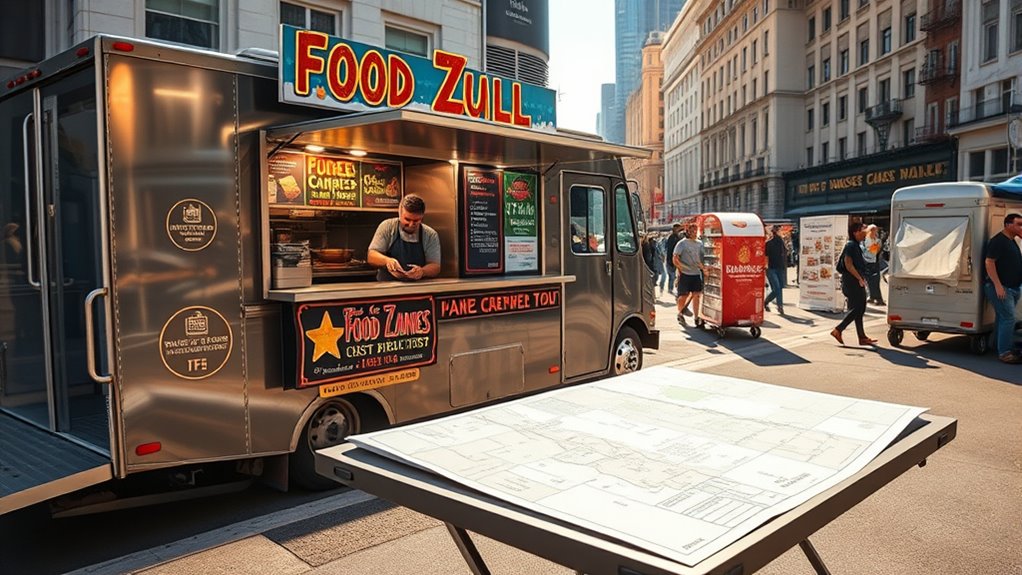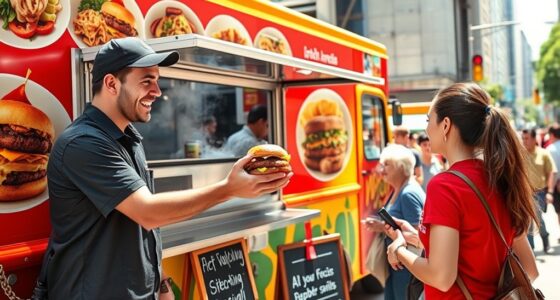Creating a business plan for your food truck helps you define your concept, target market, and operations while guiding decision-making and securing funding. Focus on outlining your menu, choosing the right location, and understanding your competition. Include marketing strategies, staffing needs, and legal requirements to guarantee smooth operations. A solid plan increases your chances of success and growth. Keep exploring these steps to gain deeper insights into building a thriving food truck business.
Key Takeaways
- Clearly define your food truck concept, target market, and unique selling points to differentiate in a competitive landscape.
- Conduct thorough market research and competitor analysis to identify demand, trends, and potential gaps.
- Develop detailed operational plans covering location strategy, logistics, staffing, and supply chain management.
- Include comprehensive financial projections, startup costs, revenue forecasts, and funding strategies.
- Outline marketing, branding, management structure, and continuous improvement strategies to ensure long-term success.
Understanding the Purpose of Your Business Plan

A clear understanding of the purpose of your business plan is essential because it guides your decisions and communicates your vision to others. When outlining your plan, you’ll need to address health regulations to ensure your food truck meets safety standards and passes inspections. Additionally, environmental considerations should be a key part of your strategy, helping you minimize waste, reduce your carbon footprint, and comply with local sustainability laws. Your business plan acts as a roadmap, helping you stay focused on these critical factors while steering through permits, licensing, and operational challenges. By clearly defining your goals and how you’ll meet health and environmental requirements, you set a solid foundation that attracts support from investors, partners, and regulators. Understanding best practices for environmental sustainability can further enhance your business’s reputation and compliance efforts.
Defining Your Food Truck Concept and Menu

To create a successful food truck, you need to clearly define your concept and menu. Consider how your concept reflects your style and attracts your target customers, and use menu design principles to keep it focused and appealing. Developing strategies for concept and menu will set a strong foundation for your business plan and future success. Incorporating a unique beach town experience can also help differentiate your truck in a competitive market.
Concept Development Strategies
Developing a clear concept is essential for setting your food truck apart in a competitive market. Focus on defining your food presentation style to create a memorable visual appeal that attracts customers. Your menu should reflect your unique concept and be priced appropriately to balance quality and affordability. Conduct market research to understand your target audience’s preferences, ensuring your offerings resonate with them. Streamline your menu to emphasize specialty items that showcase your strengths, helping with efficient food prep and consistent quality. When developing your concept, consider how your food presentation and menu pricing work together to create a cohesive brand identity. Incorporating rustic decor elements can also enhance the overall theme and attract customers seeking an authentic experience. This clarity will guide your menu development, marketing strategies, and operational decisions, giving you a solid foundation for success.
Menu Design Principles
Designing your menu is a crucial step in defining your food truck’s overall concept, as it directly influences how customers perceive your brand and experience. Focus on menu aesthetics to create a visually appealing display that aligns with your brand identity. Balance flavors carefully to ensure each dish is memorable and satisfying. Keep your menu simple but diverse enough to attract a broad audience. Consider ingredient availability and preparation times to maximize efficiency. Use color, layout, and font choices to enhance readability and appeal. Prioritize signature dishes that reflect your unique concept while maintaining consistency. Remember, a well-designed menu not only attracts customers but also encourages repeat visits through clear, enticing options that showcase your culinary style. Checking local hours can help you tailor your offerings to when customers are most likely to visit.
Conducting Market Research and Analyzing Competition

To succeed, you need to understand the demand for your food truck concept in your target area. Analyzing how your competitors attract customers and price their offerings will help you identify gaps and opportunities. This research will guide you in positioning your food truck for maximum impact. Additionally, understanding the importance of market differentiation can give you an edge over competitors.
Identifying Market Demand
Understanding market demand is essential for the success of your food truck, and this begins with thorough market research. You need to identify what customers are seeking, especially in light of current food trends and health considerations. To do this effectively, analyze local preferences, dining habits, and dietary needs. Recognize emerging food trends that appeal to your target audience and incorporate health-conscious options to stand out. Additionally, consider the importance of color accuracy in presenting your menu items appealingly, as visual appeal can influence customer choices.
Analyzing Competitor Strategies
Conducting thorough market research and analyzing your competitors’ strategies are essential steps in developing a successful food truck business. To do this, observe how competitors engage customers through social media, noting their content, promotions, and customer interactions. Pay attention to culinary trends they capitalize on, such as plant-based or fusion dishes, which can reveal gaps or opportunities. Study their pricing, menu offerings, and location choices to identify what attracts customers and what doesn’t. This insight helps you differentiate your business and stay current with industry shifts. By understanding your competitors’ strengths and weaknesses, you can refine your unique selling points and develop targeted marketing strategies that resonate with your audience and keep you competitive. Additionally, leveraging data-driven strategies can provide measurable results that inform your decisions and improve your market positioning.
Identifying Your Target Audience

Knowing who your ideal customers are is essential for shaping your food truck’s offerings and marketing strategies. By understanding customer preferences and conducting demographic analysis, you can tailor your menu and branding effectively. To identify your target audience, consider factors like age, income level, lifestyle, and location. This helps you focus your efforts on those most likely to buy your food. Additionally, researching sneaker trends can provide insights into current consumer interests and fashion influences that might resonate with your target demographic.
- Analyzing local events and foot traffic patterns
- Surveying potential customers for preferences
- Reviewing competitors’ customer bases
- Identifying popular cuisine trends in your area
- Using social media insights to gauge interests
These steps ensure your food truck appeals to the right crowd and stands out in a competitive market.
Planning Your Operations and Location Strategy

Choosing the right locations and operating hours directly impacts your food truck’s success. You need to take into account site selection factors, such as foot traffic and event schedules, to maximize sales. Additionally, planning your logistics and supply chain ensures you stay stocked and ready to serve your customers efficiently. Being aware of state tax implications can also influence your operational planning and financial strategy.
Site Selection Factors
Selecting the right location is essential for your food truck’s success, as it directly impacts foot traffic and sales. When choosing a site, consider parking regulations to guarantee you can park legally and avoid fines. Neighborhood demographics help you tailor your menu and marketing to the local crowd. Look for areas with high foot traffic, such as busy downtowns, campuses, or event venues. Evaluate nearby competitors to find underserved markets. Additionally, assess accessibility for your target customers and proximity to public transit. Picking a site that aligns with these factors maximizes your visibility and sales potential. Understanding market volatility can help you anticipate fluctuations in customer demand and adjust your location strategy accordingly.
Operating Hours Planning
How you plan your operating hours can considerably influence your food truck’s success by aligning your availability with customer demand and local activity patterns. You need to contemplate meal scheduling to target peak times, such as lunch and dinner, when potential customers are most likely to seek out your offerings. Effective shift coordination ensures that you have enough staff during busy periods without overextending during slow hours. Think about your location’s foot traffic and local events, adjusting hours to maximize sales. Flexibility is key—monitor customer flow and be willing to adapt your schedule. By strategically planning your operating hours, you’ll improve efficiency, increase revenue, and build a loyal customer base that knows when to find you. Understanding industry trends aids in job acquisition and helps you anticipate busy periods more accurately.
Logistics and Supply Chain
Effective logistics and a well-planned supply chain are essential to keep your food truck running smoothly and efficiently. Managing inventory effectively guarantees you have the right ingredients at the right time, preventing shortages or waste. Supply chain logistics involve coordinating with suppliers, scheduling deliveries, and maintaining reliable transportation routes. To optimize your operations, consider these key aspects:
- Establish strong relationships with local suppliers
- Schedule regular inventory checks
- Choose strategic locations based on demand
- Plan for peak hours and special events
- Develop contingency plans for supply disruptions
- Incorporate Self Watering Plant Pots concepts to ensure consistent resource management and reduce the risk of shortages.
Developing Financial Projections and Budgeting

Creating accurate financial projections and a detailed budget is essential for your food truck’s success. These tools help you understand profit margins and keep cash flow healthy. Start by estimating your startup costs, ongoing expenses, and revenue streams. Use realistic sales forecasts to project monthly income and expenses. To visualize key figures, consider this simple table:
| Item | Estimated Cost | Expected Revenue |
|---|---|---|
| Food and Supplies | $5,000 | |
| Equipment | $10,000 | |
| Maintenance & Fuel | $2,000 |
This clarity allows you to spot potential financial gaps early, adjust your pricing, and plan for profitability. Additionally, understanding personalities involved in your business relationships can help manage team dynamics and customer interactions. Proper financial planning ensures your food truck stays afloat and thrives in the competitive market.
Outlining Your Marketing and Branding Strategies

Once you have a clear understanding of your financial plan and budget, the next step is to focus on building your brand and attracting customers. Your marketing and branding strategies are essential to stand out in a competitive food truck scene. To guarantee success, prioritize branding consistency across all platforms and touchpoints. Use diverse marketing channels like social media, local events, and partnerships to reach your target audience effectively. Develop a compelling brand voice and visual identity that resonate with your customers. Consistent messaging reinforces recognition and loyalty. Additionally, leverage customer reviews and community engagement to build trust. A well-rounded approach ensures your brand remains memorable and your marketing efforts drive foot traffic consistently. Incorporate anime culture themes or references into your branding to appeal to a broader audience and create memorable experiences.
Detailing Your Management and Staffing Plan

Your management and staffing plan form the backbone of your food truck’s daily operations. Clear team organization ensures smooth service, while staff training maintains quality and efficiency. Define roles such as cooks, cashiers, and drivers, and establish reporting lines. Effective team organization fosters accountability and teamwork. Consider the number of staff needed during peak and off-peak hours to optimize costs. Regular staff training keeps everyone updated on safety procedures, customer service, and menu changes. Use this table to visualize your staffing ideas:
| Role | Responsibilities |
|---|---|
| Cook | Prepare food, follow recipes |
| Cashier | Handle payments, customer interaction |
| Driver | Deliver supplies, transport staff |
| Manager | Oversee operations, staff scheduling |
| Support Staff | Clean, restock, assist as needed |
Additionally, ensuring your team understands compliance with health and safety standards enhances operational efficiency.
Compiling Necessary Permits and Legal Requirements

A well-organized management and staffing plan sets the foundation for smooth daily operations, but running a successful food truck also requires compliance with local laws and regulations. To stay on top of legal compliance, you need to compile a permits checklist that covers all necessary licenses and permits. This process involves understanding health department requirements, vehicle registration, food handler permits, and health inspections. Failing to secure the right permits can lead to fines or shutdowns, so it’s essential to stay organized and proactive. Make sure you research the specific regulations in your city and state, as these can vary widely. Staying compliant not only protects your business but also builds trust with your customers.
- Know your health permit and inspection requirements
- Register your food truck as a mobile food unit
- Obtain necessary licenses for food handling
- Comply with zoning and parking regulations
- Keep records of all permits and renewals
Reviewing and Refining Your Business Plan

Reviewing and refining your business plan is a crucial step to guarantee your food truck venture stays on track and adapts to changing circumstances. Regularly evaluate your menu innovation to ensure your offerings stay fresh and exciting, attracting new customers and retaining loyal ones. Pay attention to customer engagement feedback, which can reveal opportunities to improve service, streamline operations, or introduce popular new items. Adjust your marketing strategies and operational goals based on these insights, making your plan a living document that evolves with your business. Incorporating brand reputation and product authenticity considerations can help ensure your offerings meet customer expectations and stand out in a competitive market. By staying proactive in reviewing and refining your plan, you’ll better anticipate challenges, capitalize on trends, and foster a dynamic, customer-focused food truck that thrives in a competitive market.
Frequently Asked Questions
How Often Should I Update My Food Truck Business Plan?
You should update your food truck business plan at least annually or whenever significant changes occur. Regular updates help you refine branding strategies, adapt to market trends, and stay compliant with licensing requirements. If you launch new menu items, expand to new locations, or face shifts in regulations, revisiting your plan guarantees you stay aligned with your goals. Keeping it current boosts your chances of success and keeps your food truck competitive.
What Are Common Mistakes to Avoid in My Business Plan?
They say, “A stitch in time saves nine,” so avoid common mistakes in your business plan. Be careful with overly optimistic financial projections, which can mislead investors. Don’t neglect detailed marketing strategies, as they’re essential for growth. Also, steer clear of vague goals and ignoring competition. To succeed, be realistic, thorough, and clear—your plan should be a reliable roadmap to guide your food truck’s success.
How Detailed Should My Menu Be in the Plan?
When considering your menu’s detail, focus on balancing menu complexity with clear culinary offerings. You should include enough detail to showcase your unique dishes and culinary style, but avoid overwhelming with every item. Highlight signature items and broad categories, ensuring potential investors or partners understand what you serve and how you stand out. Keep it concise, emphasizing quality and variety without overloading the plan with minor details.
Should I Include Sustainability Practices in My Business Plan?
Think of your business plan as a garden—planting seeds of sustainability today will grow trust tomorrow. Yes, include eco-friendly practices and sustainable sourcing to show your commitment to the environment. Highlight how you’ll reduce waste, use eco-friendly packaging, and source locally. This not only attracts eco-conscious customers but also sets your food truck apart as a responsible, forward-thinking venture. Your plan becomes a blueprint for a greener, more sustainable future.
How Can I Make My Business Plan Stand Out to Investors?
You want your business plan to stand out to investors, so focus on a creative presentation that captures their attention. Use compelling storytelling to highlight your passion, vision, and unique value proposition. Include visuals, infographics, and clear data to make your plan engaging and easy to understand. Show how your food truck stands out in the market, emphasizing your strengths and growth potential to leave a lasting impression.
Conclusion
As you finalize your business plan, picture yourself parking your food truck at a bustling event, the aroma drawing hungry crowds. Every detail you’ve mapped out becomes your roadmap to success—your menu, your target audience, your permits—all aligning perfectly. Like a perfectly timed meal, your plan sets the stage for a flavorful journey. Trust in your preparation, and watch your food truck become a beloved fixture in the vibrant street scene you’ve envisioned.









